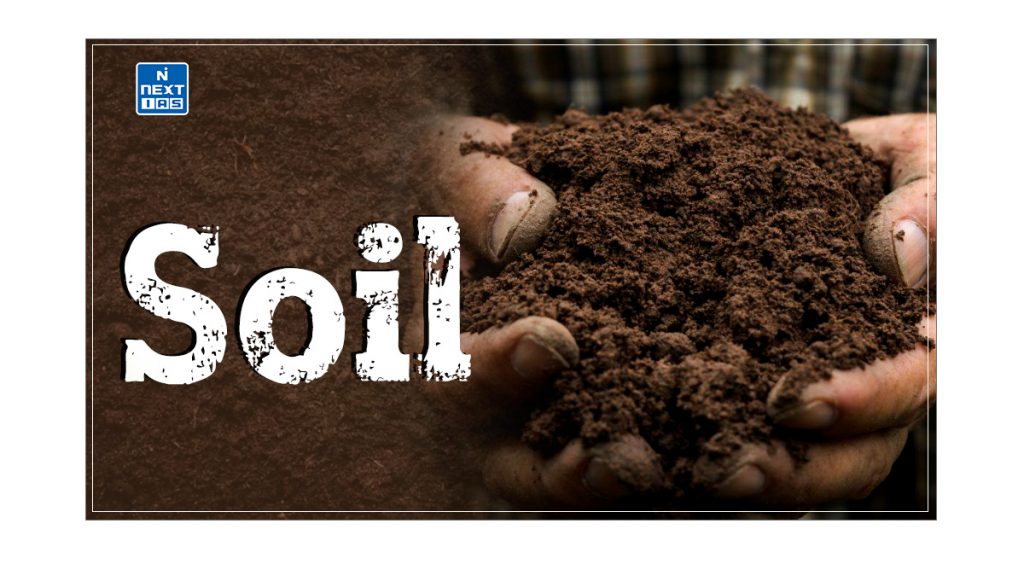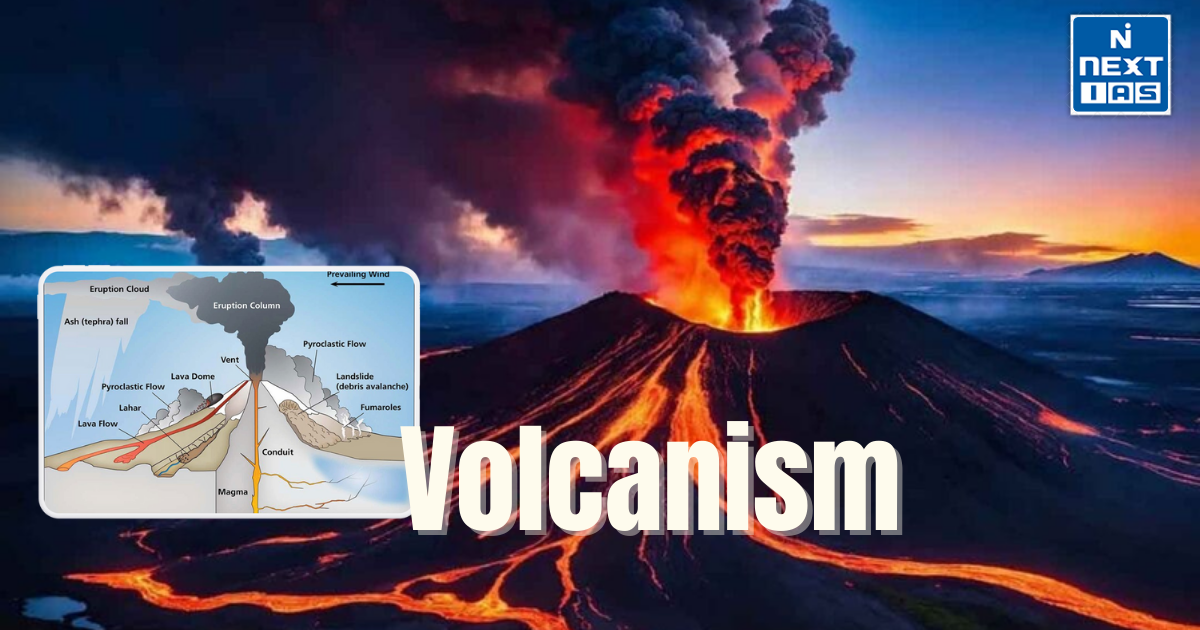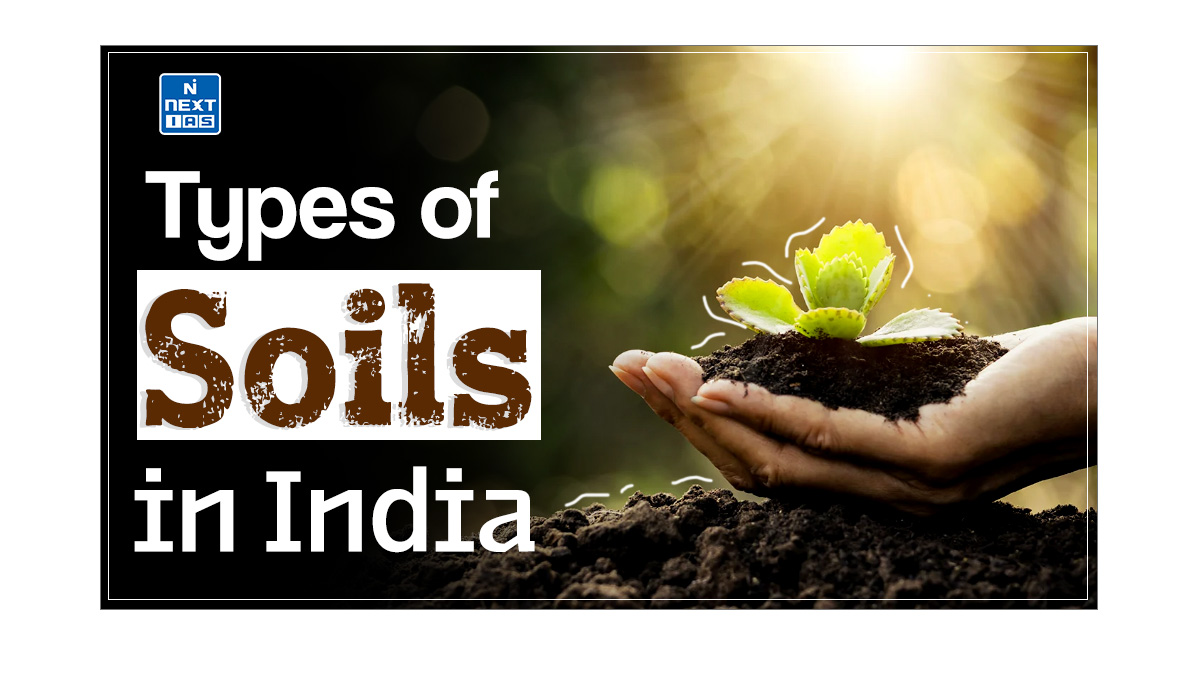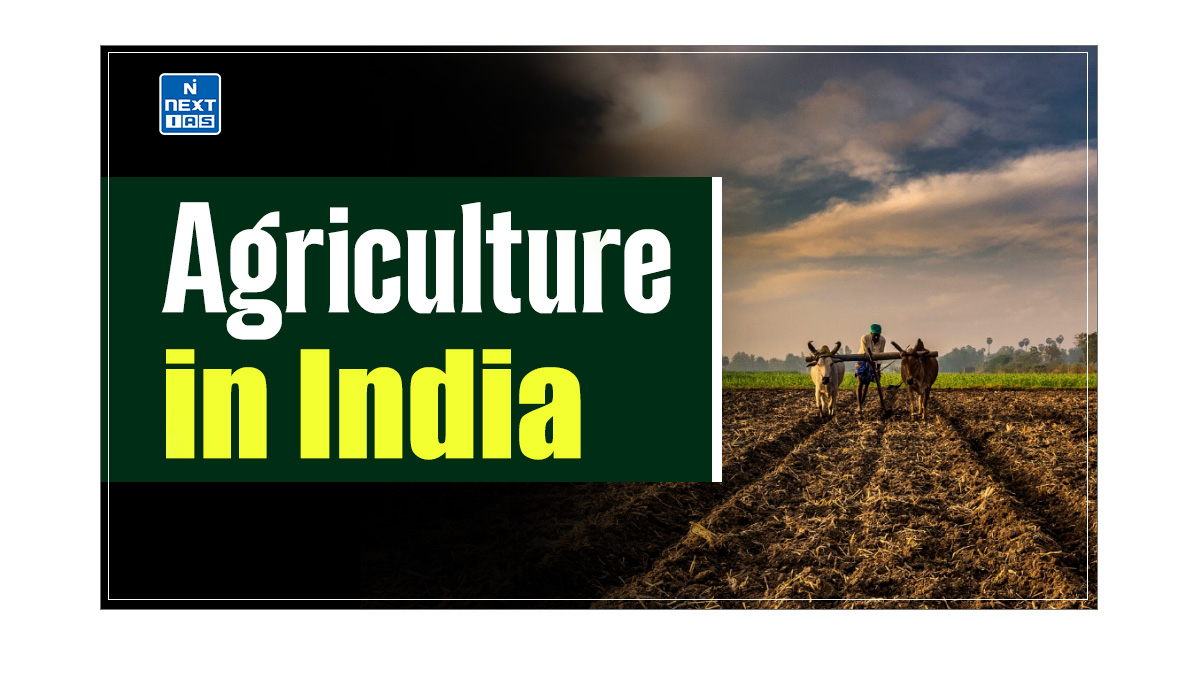
Soils are the complex, dynamic layers of rock debris and organic material that develop on the Earth’s surface. They are crucial for supporting plant life, influencing ecosystem functions, and maintaining environmental health. This article aims to study in detail the formation, profiles, characteristics, and classification of soils, highlighting their importance in agriculture and land management.
What is Soil?
- Soil is the mixture of rock debris and organic materials that develop on the Earth’s surface.
- Mineral particles, humus, water, and air are the components of soil.
- Various forces of nature, such as changes in temperature, actions of running water, wind, glaciers, and activities of decomposers, contribute to the formation of soil.
- It takes millions of years to form soil up to a few centimetres in depth.
Factors affecting the Soil formation
The significant factors affecting the formation of soil are as follows:
- Relief (viz. altitude and slope) – Determines the accumulation of soil in a particular region,
- Parent material – Determines colour, texture, chemical properties, mineral content, and permeability of the soil,
- Climate (viz. temperature and rainfall) – Influence the rate of weathering and humus formation,
- Vegetation and other life forms – Affect the rate of humus formation,
- Time – Determines the thickness of the soil profile.
These factors do not act on soil independently or in isolation but in close association with each other, leading to a whole network of inter-relationships of quite a complex nature. The soil acts as a medium for the growth of plants and supports different types of living organisms on the Earth. Hence, it is the most important natural resource necessary for sustaining life on the planet.
Soil Profile
- Soil is formed of majorly three primary layers which have different colours and compositions.
- These layers are known as horizons, and they form the soil profile.
- Thus, the soil profile is a vertical section of soil in which the soil horizons are shown.
The significant horizons of the soil are as follows:
Horizon A
- ‘Horizon A’ is the topmost zone, where organic materials have been incorporated with the mineral matter, nutrients and water, which are necessary for the growth of plants.
Horizon B
- ‘Horizon B’ is the subsoil that acts as a transition zone between ‘Horizon A’ and ‘Horizon C’ and contains matter derived from below and from above.
- It has some organic matter, although the mineral matter is noticeably weathered.
Horizon C
- ‘Horizon C’ is composed of the loose parent material. This layer is the first stage in soil formation and eventually forms the two layers above.
Horizon R
- ‘Horizon R’ is a layer in the bedrock. When the soil has direct contact with the bedrock, incredibly close to the soil surface, the bedrock becomes a variable when developing land use management plans. Its presence is noted in the soil profile description.
- Underneath these three horizons is the rock, also known as the parent rock or bedrock.
Characteristics of Soil Profile
A Soil Profile is generally characterised in terms of the following:
Soil Texture
- The ultimate size of the soil particle, called soil texture, has an important influence on soil permeability, water intake, and water storage capacity.
- Based on texture, soils are identified as sandy (2–0.05 mm average particle diameter), silty (0.05–0.002 mm), clayey (less than 0.002 mm), and loamy (mixture of sand, clay, and silt).
- The loam has the right water-holding capacity for plant growth, making it the best topsoil for cultivation.
Soil Structure
- Soil structure refers to the arrangement and organisation of the particles in the soil, i.e., how sand, silt, clay, and humus bond together to form soil beds.
- Soil structure influences the soil’s mechanical properties and can affect germination, root growth, tillage, overland traffic, and erosion.
Soil pH
- The value on the pH scale (values ranging from 0-14) that gives the concentration of hydrogen ions held by the soil particles determines whether the soil is acidic (pH<7), alkaline (pH>7), or neutral (pH=7).
- It has both direct and indirect effects on the growth of plants.
Soil Air
- The air content of the soil is vital, both to itself and to the organic life within it.
- The air in the soil helps in the process of oxidation, which converts nitrogen into a form readily available to the plants.
- Too high a degree of oxidation (in the tropical regions) may consume so much organic material that the soil becomes increasingly sterile.
- Moreover, most bacteria, present in the soil in infinite numbers, require oxygen and are said to be aerobic. The absence of air limits their activity.
Soil Temperature
- Temperature controls the biological activity of soil. Soil temperature affects germination, root-shoot growth, nutrient uptake, and plant development.
Soil Colour
- The colour of soil is related to soil constituents, such as organic matter and iron oxides. For example, the black colour of soil is due to organic matter.
Soil Consistency
- Soil consistency refers to the attributes of soil material expressed by the degree of cohesion and adhesion.
- It plays a vital role in determining the physical behaviour of a given soil-water system.
- It is described with reference to the water content of the soil. Thus, soil may be problematic when dry, friable when moist, and plastic when wet.
Soil Crusting
- This is a kind of soil compaction caused by the beating action of raindrops or wetting with irrigation water.
- Soil with a low water-stable structure slakes and gets dispersed, and the fine particles clog the soil pores.
- When such soil dries, a thin layer or hard crust of soil is formed, presenting a serious barrier to seedling emergence.
Types of Soils in India
The varied relief features, landforms, climatic realms, and vegetation types of India have contributed to the development of various kinds of soils in India. Based on this, the Indian Council of Agriculture Research classified soils into eight types:
- Alluvial Soils,
- Red Soils,
- Black Soils (Regu),
- Desert Soils,
- Laterite Soils,
- Mountain Soils,
- Alkaline Soils, and
- Peaty and Marshy Soils.
Read our detailed article on the Types of Soils in India.
ICAR Classification of Soils
The ICAR has also classified soils of India based on their nature and character, as per the United States Department of Agriculture (USDA) Soil Taxonomy. ICAR has classified the soils of India into the following order as per the USDA soil taxonomy:
| Names of Soils | Area (in thousand hectares) | Percentage |
| Inceptisols | 130372.90 | 39.74 |
| Entisols | 92131.71 | 28.08 |
| Alfisols | 44448.68 | 13.55 |
| Vertisols | 27960.00 | 8.52 |
| Aridisols | 14069.00 | 4.28 |
| Ultisols | 8250.00 | 2.51 |
| Mollisols | 1320.00 | 0.40 |
| Others | 9503.10 | 2.92 |
| Total | 100 |
The ICAR classification of soils of India has been discussed in detail in the following section.
Oxisols
- These soils develop in the hot and humid climates of the equatorial region.
- These soils are called oxisols because they have a distinctive horizon with a mixture of iron and aluminium oxides.
- Related vegetation is the luxuriant and diverse tropical and equatorial rainforest.
Aridisols (Desert Soils)
- The largest single soil order occurs in dry regions of the world.
- These soils occupy nearly 19 per cent of the Earth’s land surface.
- They are pale and light near the surface, moisture deficit, and lack organic matter.
- Salinisation is the main problem of these soils, complicating farming in Aridisols.
Mollisols (Grassland Soils)
- They are the most productive soils on the Earth, rich in humus content, and have a dark-coloured surface.
- Mollisols are soft, even when dry, with granular pads that are loosely arranged when dry. These humus-rich organic soils are high in basic cations and exhibit high fertility.
- The soils of the steppes and prairies worldwide belong to this group. These soils are utilised for large-scale commercial grain farming and grazing.
- The process of calcification is very strong in these soils. When cemented or hardened, these deposits are called calche or kankar.
Alfisols (Moderately Weathered Forest Soils)
- These are the most widespread soil orders, extending from near the equator to high latitudes.
- Pale, greyish-brown to reddish in colour, they are considered moist versions of the Mollisols soil group.
- Alfisols have moderate-to-high reserves of basic cations and are fertile.
- However, their productivity depends on moisture and temperature. They are supplemented by the moderate application of lime and other chemical fertilisers. Some of the best agricultural farms in the USA have this soil type.
Ultisols
- These highly weathered forest soils are found in temperate climates. They tend to be reddish in colour because of residual iron and aluminium oxides in the A horizon.
- The increased precipitation in Ultisol regions means greater mineral alteration, more leaching, and, therefore, a lower fertility level.
- Certain agricultural practices and the effects of soil-damaging crops such as cotton and tobacco further reduce fertility. These soils need substantial management.
Spodosols (Coniferous Forest Soils)
- Found in the humid continental mild summer climates. Their distribution is found in North America and Eurasia.
- They are not found in the southern hemisphere.
- Spodosols lack humus and clay in the horizons.
- The leaves of the conifers add acidity to the soil. They are ash gray and are also known as podzol soils. These are not very fertile soils.
- To enhance the fertility, the application of lime is required.
Entisols
- Usually young or underdeveloped.
- Lack of vertical development of horizons.
- These are less fertile soils. Dunes, ergs, outwash glacial plains, poorly drained tundra, tidal mud flats, etc., are examples of Entisols.
Inceptisols
- These soils are inherently infertile.
- They are usually weakly developed young soils though they are more developed than Entisols.
- They include the soils of most of the arctic tundra and outwash moraines.
Andisols (Volcanic Parent Materials)
- The term Andisols has been derived from volcanic ash and glass.
- Highly fertile and have a high water holding capacity.
- These soils occupy a relatively smaller area, especially around the volcanic ring of fire in the Pacific Rim.
- Examples are the fertile soils of Hawaii that produce sugarcane and pineapple as important cash crops.
Vertisols (Expandable Clay Soils)
- Composed of more than 30 per cent clays.
- Vertisol clay becomes black when it gets wet and hard when dried.
- While drying, Vertisols cracks the soil, and the cracks widen and deepen as the soil dries.
- The Regur soils of India are an example of Vertisols.
Histosols (Organic Soils)
- Formed from accumulation of thick organic matter.
- Bog marshes are examples of Histosols. Dried Histosols are used as low-grade fuel.
Conclusion
Soil is a dynamic and vital component of our environment, playing a crucial role in plant growth, water filtration, and supporting diverse ecosystems. By comprehending the different soil horizons and their functions, along with the various soil types in India, we can develop better conservation practices and sustainable land management strategies. Ensuring the health of our soil is vital for agricultural productivity, environmental stability, and the overall well-being of our ecosystems.
Frequently Asked Questions (FAQs)
What is Soil?
Soil is the upper layer of the earth’s surface composed of mineral particles, organic matter, water, and air.
How is soil formed?
Soil formation is a complex process involving the weathering of rocks and the decomposition of organic matter over long periods.
What is Soil Profile?
A soil profile is a vertical section of soil that displays its various layers, known as horizons.
How many types of soil?
There are six types of soil – clay, sandy, peaty, silty, chalky, and loamy soil.
How to prevent Soil Erosion?
Soil erosion can be prevented through plant vegetation, mulching, terracing, contour ploughing, grass cover and building retaining walls.
How are nutrients replenished in the soil?
Nutrients can be replenished in the soil through composting, green manure, fertilisers, crop rotation, etc.






